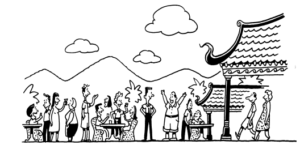
Management retreats are tremendous opportunities to review, assess, align and move your team forward. Get the most out of your next retreat through effective planning, preparation and the employment of customer service skills.
These ten keys and customer service skills can help you unlock the amazing power of your meeting:
1. Select your site with care.
Your management retreat can be held on-site (at your place of work), or off-site (at a home, hotel or conference venue). Each has its advantages:
On-site events keep costs low and familiar business facilities close at hand.
Off-site events reduce distraction and can promote a “big picture” perspective.
Be careful not to mismatch your event theme and conference facility. If your theme is “nose to the grindstone,” don’t hold your retreat at Disneyland. If your theme is “stepping back to view the horizon,” don’t hold your retreat in a busy downtown conference center. Use good customer service skills and creative thinking to match the venue and theme.
2. Design your sequence with care.
Use customer service skills to time your schedule. The timing of your entire agenda is key to your success. Decide early whether you want a high-intensity working event, a laid-back and relaxing retreat or a balanced program combining both styles.
If you intend to combine work and play, carefully consider which should be first.
“Work first, play later” gives participants something to look forward to, and a reason to get through business issues quickly.
“Play first, work later” sets a tone of enjoyment for the program and puts work issues closer to your return to the office.
“Work, play, work” lets you get started on business issues, take a break and then come back to complete your work after gaining some recreational perspective.
3. Circulate a pre-retreat agenda.
It is just a good exercise of customer service skills to let people know what your objectives are for the retreat and the sequence of the program they will attend.
Give everyone an opportunity to prepare for full and constructive participation. If they need to bring information, give a presentation, participate in a panel or work on a team, let them know well in advance. They will appreciate your customer service skills.
4. Use breaks to your advantage.
Use meals and coffee-breaks to make progress in your program. Arrange seating at meals to foster communication. Turn some coffee breaks into “working breaks” with refreshments inside the conference room.
Select food very carefully. Avoid fried foods and heavy gravies – both put participants to sleep!
Start lunches with salad, not soup. Salad can be served in an instant or be on the table when your participants arrive. Soup takes time to come hot from the kitchen, gets cold quickly and can set your entire agenda back by 10–20 minutes if it is not ready on time.
If you plan to serve alcohol during dinner, let the evening events be pure fun. Alcohol and focused attention don’t mix well together. Use good customer service skills to set the correct agenda for your business.
5. Present new perspectives.
Create a perspective not usually seen at the office. Bring in examples from outside your industry to highlight key points. Engage external speakers to share cross-industry knowledge and unique expertise.
6. Involve customers as your guests.
Bring in customers for specific portions of your retreat. Golf games are traditional, but customer panels and discussion groups can also yield valuable results. Involvement provides an important lesson about customer service skills that are truly important to your clients.
7. Involve suppliers as your guests.
Strengthening your partnership with suppliers makes good business sense and is a good application of customer service skills. Suppliers can add unique value to your management retreat by sharing their perspective and competitive industry awareness.
8. Circulate post-retreat actions and agreements.
Put decisions and new action plans in writing. Send copies to retreat participants with an encouraging or congratulatory note from the top. Participants will appreciate this demonstration of good customer service skills.
9. Gather input and recommendations.
After the event, or before everyone departs, gather their ideas for further improvement. Ask what participants want more of, and less of, at your next retreat. This is just a good application of customer service skills that will improve your events as you go.
10. Use an outside process facilitator.
It can be useful to engage a professional facilitator to help with your retreat. Outside talent can bring years of experience to help design your event. A competent external facilitator can also serve as a “neutral party,” making sure that everyone speaks and is heard.
If you do engage an outside facilitator, don’t let him or her get caught uninformed! Be sure to provide detailed information about your business – and about the personalities attending your event. Your facilitator will appreciate your customer service skills!
—————————————————————————————————————————–
You may use this article in your free newsletter, website or publication providing you include this complete statement (below) with active links to the websites:
Copyright, Ron Kaufman. Used with permission. Ron Kaufman is the world’s leading educator and motivator for upgrading customer service and uplifting service culture. He is author of the bestselling “Uplifting Service” books and founder of Uplifting Service. To enjoy more customer service training and service culture articles, visit www.RonKaufman.com.
For commercial use of this article in a paid newsletter, publication, or training program, please contact us.



